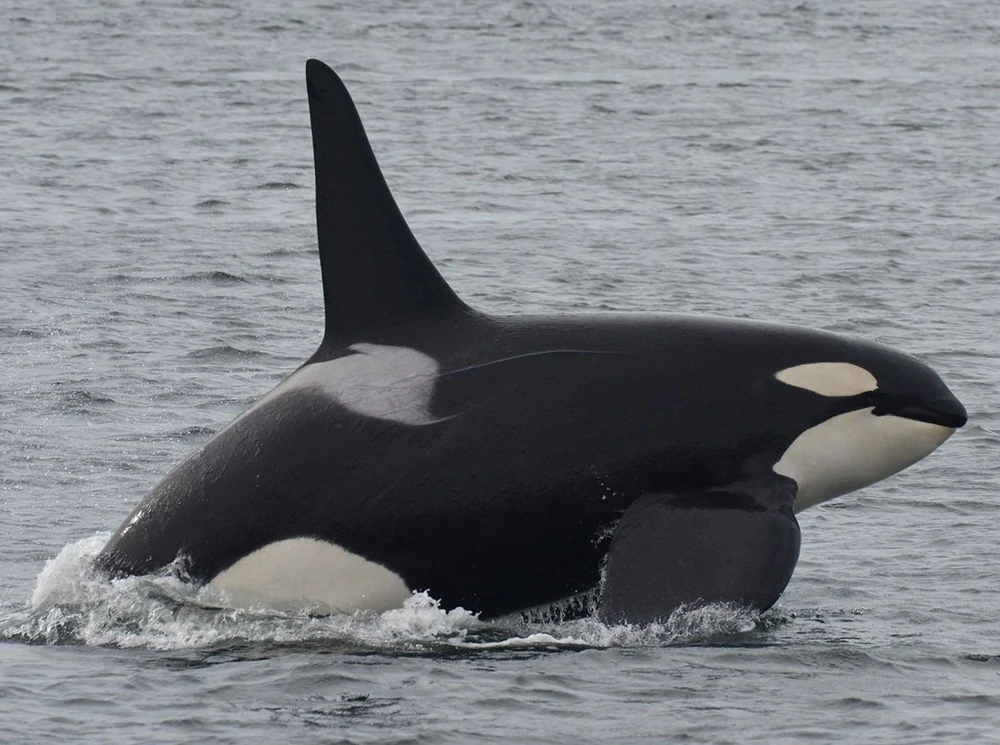UPDATE: July 14, 2016 – Blackberry was finally spotted with J Pod and we are thrilled! To see his picture, visit our Facebook page!
J27 Blackberry currently missing. As one of our Naturalists, Izzy mentioned in a previous blog post, it’s hard for us naturalists not to feel a special connection to certain whales in the Southern Resident community. My favourite whale has always been J27 (Blackberry). Blackberry was born in 1991, which makes him 25 years old this year. He travels with his two siblings, younger sister J31 (Tsuchi) and youngest brother J39 (Mako). These three siblings lost their mom, J11 (Blossom), back in the summer of 2008. That was my first year as a naturalist in the Victoria whale watching industry, and Blackberry and his newly-orphaned brother and sister were some of the first Southern Resident killer whales that I met. Blackberry instantly became my favourite: with his wide, stately dorsal fin and unusual saddle patch, he’s easy to recognize. He’s also a bit of a ham – he often surfaces slowly, giving lots of warning for photographers to get a great shot, and he has a tendency to head toward boats (much to the captains’ chagrin), almost as if he’s curious about us, as well.
Last week, when J Pod was seen in the Salish Sea, there was a notable absence: Blackberry’s siblings and close relatives were there, but Blackberry himself was missing. This is not a good sign – male killer whales spend their entire lives with their ‘matriline’ – their mom and siblings, and their female siblings’ offspring. After his mother died, all Blackberry and Mako had was their sister Tsuchi who, although she is nearly 21 years old, has never been seen with a calf of her own. These three tight-knit sibs had their extended family, but were nearly always seen swimming side-by- side. If Blackberry is not with the group, it would be extremely unusual. The whale watching and research community is fearing the worst.
I’ve watched Blackberry for the last eight years. I’ve watched him grow from a goofy 17 year-old ‘sprouter’ (a male who is undergoing puberty and whose adult male fin is still growing) to a sexually mature 25 year-old. I’ve seen him taking care of his little brother Mako, who is now starting to sprout his own grown-up fin. I’ve seen him messing around with his cousin J26 (Mike), of whom Blackberry is of an age, back before the two started swimming in separate ‘subpods’ of J-Pod. Those two hooligans used to love playing with the calves, demonstrating breaches and watching the young ones try to emulate their style. I’ve seen Blackberry courting females, shadowing them and showing off. Although I’m sure Blackberry has no idea who I am, I feel as though I’ve grown up with him.
When I heard that he was reported missing, my heart stopped. Blackberry is a male in his prime, but that doesn’t mean he is invincible: several males in the last few years have gone missing at similar ages, despite the average lifespan for a male killer whale being 30 years. This epidemic of untimely deaths among young killer whales may be the result of a very threat that killer whales face as top predators: the bioaccumulation of toxins in the ocean resulting from the dumping of man-made chemicals. Predators near the top of the food chain are the most impacted by this accumulation, and males are especially vulnerable because they have no way to offload the toxins (females can lose some of their toxin load by giving it to their calves).
I am extremely saddened by the news that Blackberry is missing. I am hoping against all hope that he is found soon, but preparing for the worst.
__
Kat Nikolich, MSc
Onboard Naturalist/Biologist for SpringTide Whale Watching & Eco Tours

